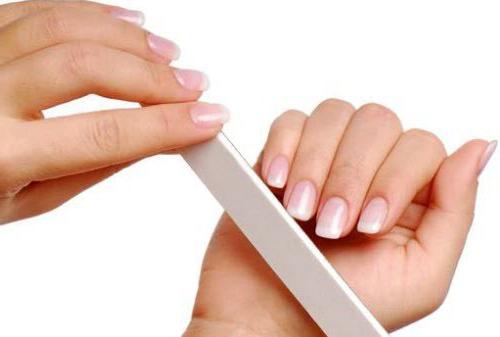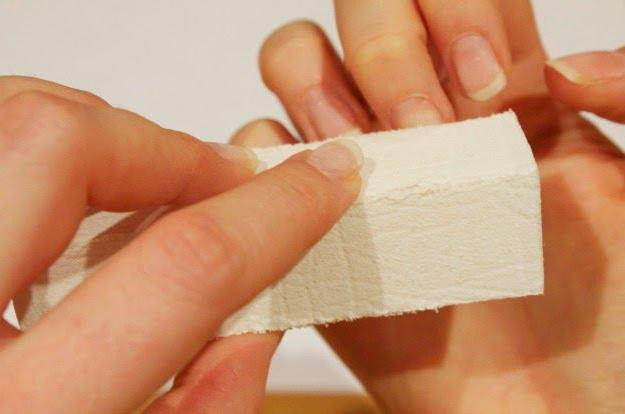Polishing buff for nails. What is a buff: purpose, types and technique of use
The usual way for many people to polish their nails is with a nail file. However, this is not the only option to give smoothness. Using a buff for the nail plate, you do not injure it, acting more delicately. This ordinary bar replaces many salon procedures during manicure and is successfully used at home.
What is a buff for polishing nails
Buffs act on the nail plate on the same principle as nail files, so they use bars as professional tool for a manicure. The main difference between a buff and a nail file is its fine grain, which makes it multifunctional. What is the buff for? The tool is great for the care of false and natural nails. At home, the bar is used in a complex way: for polishing, grinding, shaping the nail plates.
Types of nail files
The buff polishing file is made from different materials. Fabrics, plastic or wood are taken as the basis, the work surface is made of suede or silicone, and the graininess is created in several varieties. As a rule, a nail buff is a voluminous four-sided bar with numbered sides. Numbering is used in order to know which function to apply during a manicure.
- The first side gives the desired shape to the nail.
- The second face removes the unevenness of the nail plate.
- The third side is grinding, with its help flaws are smoothed out.
- The fourth face is the final polishing of natural nails or gel (acrylic) to a shine.

Abrasiveness
For polishing natural nails and building them up, a buff is better than a file, as it has more functionality. The advantage of a polisher is its varying abrasiveness, which determines what the tool will be used for. There are several indicators indicating the number of pores (grits) on the surface of the bar:
- The abrasiveness of the files 60-80 grit means that the tool does an excellent job of polishing acrylic nails, because the surface of the buff in this case is rough and hard.
- Bars marked 100-150 grit are ideal for treating toenails and before applying gel polish. Such abrasiveness effectively removes all irregularities.
- The abrasiveness of the grinding tool 150-240 grit means that it is desirable to use it for filing the ends of natural or polishing artificial nail plates.
- Marking 300 grit and above is the smallest and softest. These bars are used for final polishing.

How to buff nails
The buff for polishing nails is used in almost the same way as the usual nail file, but it has its own nuances. In order not to harm the nail plate and achieve the desired results, apply the buff correctly:
- Apply the working surface of the grinder to the nail plate with the wide side to capture the largest possible surface.
- During processing, make as few movements as possible.
- The nail file is not designed to be processed every day, so it is advisable to use it no more than once a week.
- After polishing, professionals advise nails to “seal” so that they do not exfoliate. To do this, drop any essential oil on the nail platinum, and then process it with the softest side of the grinder.
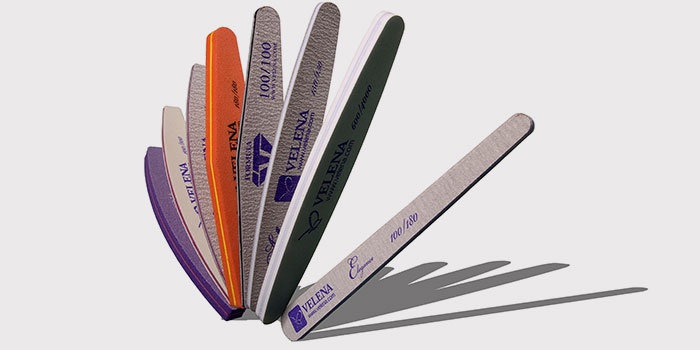
How to disinfect manicure tools
You need to use a buff in the same way as a nail file, that is, it is imperative to process manicure tools. Over time, dirt and pathogenic microorganisms accumulate in the polishing bars, so before each use, do not neglect the treatment with a disinfectant. To make it easier, choose a tool that is preferably non-capricious in care.
Buffs absorb water excessively, so it is not recommended to wet the bars so that they do not exfoliate and deform. Based on these considerations, you should choose plastic polishers from the entire range presented in the store, which are easy to disinfect and last a long time. If you have a budget, then it is better to purchase a set of bars with a variety of abrasiveness and from various materials to find the right individual tool.
Price
It is not a problem to choose buffs wholesale or retail now. Moscow stores offer a wide range of manicure tools of different brands. If you seem high prices in stationary outlets, then turn your attention to online stores, where grinding blocks at a more affordable price are easy to choose from the photo.
| brand name | average cost buffs (region - Moscow) |
| Dead Sea Premier | |
| Salon Professional |
Most girls who care about their appearance know how important well-groomed hands are. After all, a carelessly done manicure can pretty spoil general impression from a carefully thought out image. Using it, you can quickly and effortlessly achieve smoothness and shine of the nail plate.
What are buffs?
The principle of operation of this tool is practically no different from a conventional file. The only important difference is the finer grain. Nondescript at first glance, the bar perfectly copes with its functions and can easily replace some professional procedures. The tool, ideal for the care of natural and artificial nails, is very convenient for home use. To date, several varieties of buffs are produced. Usually they are made on fabric, plastic and wooden base. The work surface itself is made of suede, silicone and other materials.
How to choose a nail polishing tool?
In modern stores a wide range is presented. To choose a high-quality nail buff, you need to decide for what purpose it is purchased. You should not save on the purchase of this tool, the more expensive it is, the longer it will last. A cheap product will be erased after two or three procedures.
When choosing a buff for polishing nails, you should pay attention to Special attention to the shape of the product. To date, two types of instruments are considered the most common. The first is made in the form of a tetrahedral bar, and the second, more practical option, looks like a thick sandpaper file with only two working surfaces. Such a product is much more convenient to use and easily copes not only with polishing, but also with grinding the nail plate. As a rule, manufacturers producing square bars mark each side. This is necessary in order to make it easier to figure out for what purposes this or that face is used. The first side is used as a regular nail file: to give the desired shape. With the help of the second face, all irregularities are carefully removed from the surface of the nail plate, the third is needed to eliminate the smallest defects, and the fourth is for the final polishing.
Tool abrasiveness
A buff nail file is equally good for processing natural and natural nails. The only difference between them is the graininess and abrasiveness of the tool. For processing natural nails that do not have serious defects, a grinder with a standard grit (220-280 grit) is suitable. Such a block is delicate enough not to scratch the nail plate. Owners of acrylic manicure are recommended to use a grinding tool, the grain size of which does not exceed 240 grit.
Before you start polishing your nails, you need to familiarize yourself with a few simple rules. The procedure is not recommended to be carried out more than once a month. Otherwise, it may result in delamination and brittle nails. For a successful procedure, you must learn how to properly hold the nail buff. In order for the tool to have the same effect on the entire surface of the plate, it must be taken from both sides. To maintain the maximum effect of polishing, a small amount of nourishing cream is first rubbed into the nail.
Instrument disinfection
Some girls are worried that in the salon, which uses a common nail buff, you can pick up some kind of infection. To dispel your doubts before starting the procedure, it is advisable to ask if the instruments are disinfected there. Usually, after each client, buffs are soaked for 20 minutes in a special solution that can neutralize all microbes. Most expensive salons have more modern sterilizers made in the form of germicidal ultraviolet lamps.
If the master's answer did not dispel your fears, then you can bring your own tool. Some specialists keep their clients' buffs in special paper bags, which eliminates the need to constantly carry them with you. Do not forget that over time, dirt and pathogenic microbes begin to accumulate on the instrument. Therefore, the nail buff needs regular care. However, some tools are able to absorb moisture, so they cannot be treated with special disinfectants. For example, tissue varieties that have enough short term operation, upon contact with water, they begin to instantly deform and delaminate. Therefore, most experts recommend giving preference to buffs that do not require special care. Alternatively, you can purchase a more durable plastic counterpart, which is better disinfected.
In order for a manicure to be irresistible, it is necessary to use the right equipment and tools. In addition to the classic nail files, every girl should have a buff in her arsenal. A buff is a special file, represented by a voluminous rectangle, which can be used for both natural and artificial nails. Translated from in English the name means “to polish”, which actually reflects the main functions of the device.
Why do you need a polishing buff for nails
Buff is a universal tool that is used both at home for self-correction of nails, and within salons. For manicure in salons, disposable buffs are often used to polish the nail plates. However, today's technology allows you to create nail files from a wide variety of materials, many of which can be.
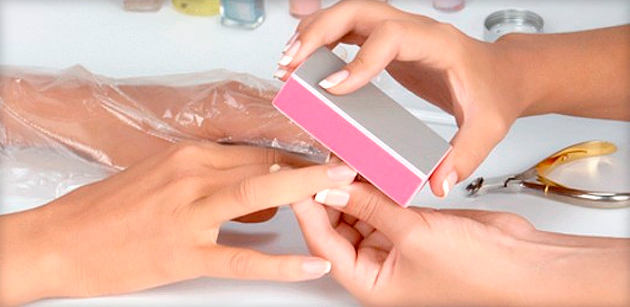
Apply the described tools for grinding the surface of the nail plate. This necessary measure before applying any product, be it modeling gel or regular varnish. Such a file allows you to remove all irregularities and flaws on the surface of the nail, which is especially important for multi-layer extension procedures. In this case, it will be fair to say that good polishing is the key to a high-quality and even coating, and, accordingly, the manicure itself.
What buff is better to polish nails: abrasiveness
We have already found out that a buff is also a file, but there are significant differences. The peculiarity of polishing blocks is that they are made of softer materials and have greater delicacy. Specific devices are classified according to the material from which they are made (fabric, glass, plastic, etc.), as well as abrasiveness. Abrasiveness is a criterion that determines the amount of grits, that is, "pores" on the surface of the bar.
Abrasiveness determines what the tool will be used for, as well as what type of nails it is intended for.

Depending on the purpose, allocate the following types buffs:
- abrasiveness from 60 to 80 grit. Bars of this type are used to work with artificial fingernails or for pedicures. These buffs are distinguished by a high degree of rigidity and rudeness;
- abrasiveness from 100 to 150 grit. Used to correct extended nails, for example, before gel polish. This indicator of roughness allows for high-quality polishing with the removal of all irregularities. Files with a similar indicator are also successfully used to polish the surface of the toenails;
- abrasiveness 150 - 240 grit. Use to work with artificial nails or filed your own nails;
- abrasiveness of 300 and above allows the use of files in working with natural nails. The use of the tool makes it possible to qualitatively polish the nail plate to a shine.
How to choose a tool for natural nails
All polishing blocks are divided according to the type of coating and abrasiveness, the variety of types of tools opens up a wide range to the consumer, so you can special work select the required saw blade. As for natural nails, the anatomical features of the nail plate should also be taken into account. The thinner the nail, the more abrasive should be.

To work at home with natural nails, it is best to choose buffs with a parameter from 300 to 1000 grit. Accordingly, thick plates are polished with bars with a setting of 300-500 grit, and in order to achieve shine from thin nails, you need to buy a product with more high value- starting from 500 and above.
How to use a polishing buffer
In order for the manicure to turn out to be of the highest quality, you should follow a number of rules for the correct correction of nails using a tool such as a buff file. The main conditions for the use of the correction element include:
- first of all, you should apply the nail file with the widest side to the nail and this should be done in such a way that the surface captures the maximum area of \u200b\u200bthe nail;
- the less movement is carried out, the less likely it is to harm the nail plate;
- when polishing, the direction of the cut should not change. The procedure is carried out in two directions - to the right and to the left along the width of the nail;
- to resort to the use of the described device should be no more than once a week. Otherwise, there is a risk of thinning the surface of the nail and thereby causing serious injury to it;
- monthly it is necessary to drink with the help of a buff and strengthening essential oil the root of the nail, thereby sealing it.
Video: polishing nails with a buff
What can replace the buff for nail treatment
Buff is a necessary tool, the emergence of which was facilitated by the development of the technological process. If in a certain situation such a tool was not at hand, then you can use an ordinary nail file with the appropriate abrasiveness, but this will not guarantee a quality result. In the most extreme case, you can resort to improvised methods, taking, for example, a piece of coarse cloth. In any case, the grinding device must be present at the initial and final stages of manicure - both regular and with the use of gel polish.
When you come to the store for a tent, a sleeping bag and other vital equipment, things like a buff seem distant, secondary and unnecessary. However, it is worth going on a hike, and the eye stops at bright, multi-colored things that tourists so happily wind around different parts of the body: arms, heads, necks. Among hikers there is a whole unspoken club of lovers and admirers of this overseas miracle.
So what is buff? Buff is a single piece of synthetic fabric (a kind of "sleeve" without seams) with excellent sweat-wicking properties. More precisely, Buff is the name of the brand itself, and the original thing is called "bambas", but that's not the point. If you are a fan of thermal underwear, fleece and membrane clothing, but you haven’t got your hands on a tourist buff yet, be sure to try it, you will like it in all respects, from versatility to weight. It is also very easy to wash wild environment It dries up in just minutes.
There are whole schemes and manuals on how to spin this thing in a given situation. Indeed, within a few minutes, a bandana can turn into a wristband, and from it into an elastic band for hair or into a scarf, balaclava, etc.
I first tested this device on myself several years ago, since then I have had many and different ones. At the same time, all available buffs are useful, and not only for themselves. The thing is light and does not take up much space in the backpack. One of your friends forgot a hat - and you have this super-gadget in the bins. Or it became cool in the evening - you make the “cup” option, and voila - a cap of two layers on your head, which immediately reduces heat transfer.
There are two types of classic buffs. Firstly, warm, which consist of two parts - half fleece and half light fabric. Such buffs are very suitable for hiking in the cold season and, of course, for skiing activities. But in the summer, such a thing is of little use, for hot weather there are light tourist buffs - no fleece is provided here.
Beware of fakes! The travel buff isn't cheap considering it's a small piece of cloth. Sometimes the same wonderful bright gizmos are offered for favorable prices other manufacturers, but experience has shown that few of them can boast of real quality. Cheap analogues suffer essential function- removal of moisture. They can also shed and stretch, as well as become covered with unpleasant spools. But the real Buff will serve you faithfully, always remaining the same bright, elastic and, of course, a favorite item of a camping wardrobe.
Why a woman's eyes light up when looking at a manicure tool, psychologists would explain, but whatever underlies this craving, every girl has a travel bag filled with manicure devices that for some reason so often frighten men. I must admit that many of them are not superfluous, but quite replaceable, but this definitely does not apply to the buff. Some salon procedures, cleaning chemical solutions - this is what replaces the buff for manicure at home.
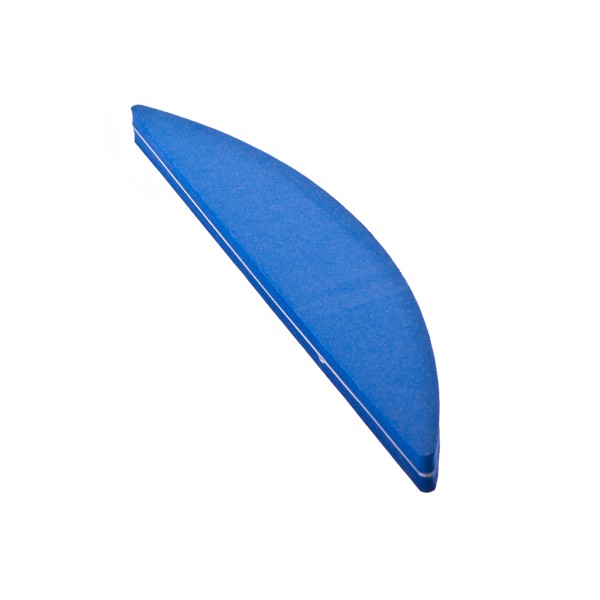
Why haven't many people heard of buff?
Very often, when they hear the word “buff”, “buff”, many people ask: “what is it?”. Buff is a professional tool for manicure masters to prepare natural and extended nails for varnish, gel, shellac. Maybe that's why, not every manicure set of every young lady has this tool yet, but from a professional one it is gradually turning into an indispensable item for self-care of the nail plate.

Buffs come in different modifications, depending on its purpose. Also buffs can have different shape and materials. One of the most common and convenient forms is in the form of a block, a parallelepiped, the sides of which are coated with different materials: polyethylene foam, silicone, fabric or an abrasive pad.


The softer and smoother the surface of the bar, the more carefully it must be handled, since such softness of the material is deceptive. The nail can be “polished” and will have to be restored for a long time, growing healthy.
A buff whose sides have varying degrees abrasiveness, i.e. very strong coarse or weak fine granularity of the surface, are intended for processing artificial nails and natural ones. The low abrasiveness marker, calculated in grits, indicates that this file is for pedicure and acrylic, gel nails. Their processing and preparation for applying color coating. 60-80 and 100-150 grit are suitable for these manipulations. These sides can be used by masters when working with a natural nail to prepare for extension, but without knowledge and skill, self-application can damage the nail.
A high abrasion marker indicates the use of a buffer for grinding and polishing a natural nail. 150-200 grit is used for grinding, for polishing from 300 grit, no less. The right tool is the health of the nails and a beautiful appearance.



Applying a buff for healthy nail beauty
The next question is: “what is the buff for?”. The buff gives the desired shape to the nail, evens out the surface, polishing it - makes it perfectly even to the eye and to the touch; polishes, bringing the smoothness of the plate to perfection, and induces a radiant shine of healthy nails. When working with a buff, you need the right approach, this is especially important in the processing of natural nails.
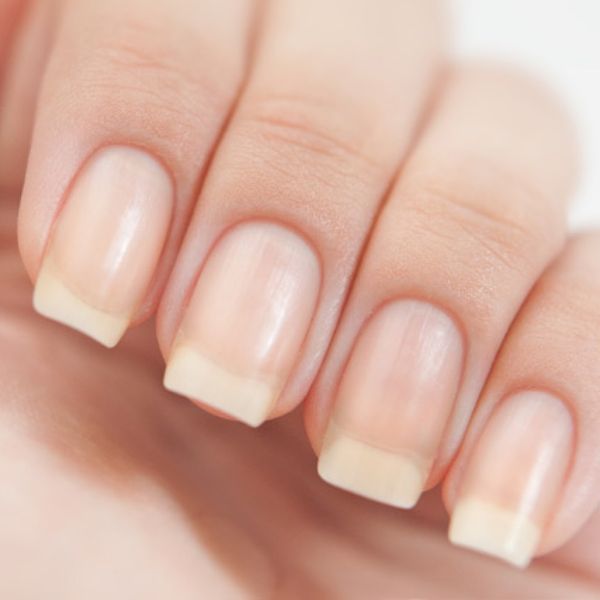
The danger of using a buff is that you can overdo it, as this soft bar does not give the impression of possible harm. These are not tweezers with which you can get hurt to the point of blood and the wound will not heal for a long time, not a pusher with a sharp “hatchet”, just a fabric, suede, silicone block. As with the above tools, when using a polishing file, certain conditions must be followed. Proper handling nail is a guarantee of quality and well-groomed nails.

The polishing block is contraindicated for owners of thin, exfoliating nails. Their fragility will only be exacerbated by the use of a buff. Preparation of nails before extension using abrasive pads is a separate issue, now we are only talking about grinding and polishing a natural nail. These operations are carried out with slight differences, which few people pay attention to.

Procedures with a buff for nails
Grinding the nail is the alignment with the elimination of obvious defects - unevenness, ribbing of the nail. The stiffer, grainy side of the block is used. The direction of movement of the file at this stage is clearly regulated - according to the growth of the nail plate, from the base to the end of the nail. It is better not to use the "back and forth" movement. Sliding buff barely touching the surface, without pressure goes in the center of the nail and from the sides. Several movements with each nail, without diligence. 
Polishing a nail is like polishing a silver tray, you have to be very careful not to scratch the soft metal. Polishing takes place in different directions. In order not to make unnecessary movements, the number of which is limited, the entire plane of the nail is captured in the process.
A popular procedure - "sealing" of nails is aimed at combating delamination of the nail plate. Held last step, essential oils and special mixtures for nails are used. After applying a thick layer, the same polishing of the surface and end of the nail begins. The procedure is very useful for nails and cuticles, in order to do it even more often, you can use an old tool that, due to prescription, no longer polishes and, as a polisher, it is of no use. But it perfectly performs the function of sealing, sealing, massaging and moisturizing the cuticle. It is better if the bar is silicone.



The procedure for grinding and polishing nails is useful when performed once every two or one week, but it would be more correct to take a closer look at the reaction of the nails, your own regimen may form.
Buff care
How to process a buff after a nail correction procedure does not differ from the methods for processing any manicure tool. Washing with soap is the first option, but not very suitable for suede buffs. Treatment with disinfectants and antiseptics intended for the care of manicure accessories is possible. Using a sterilizer is one of the ways, but even it will not destroy harmful bacteria, microorganisms on suede, so buffs from this material are best left for home use and should not be used in a salon procedure.
Video selection on the topic of the article:

